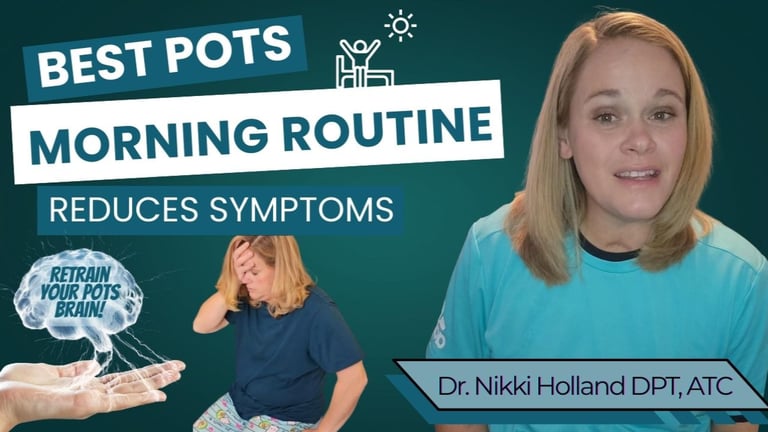Morning Moves for POTS: How to Start Strong Every Day
Discover a POTS-friendly morning routine with hydration, gentle exercises, and tips to manage symptoms and start your day strong.
CHRONIC CONDITIONS
12/10/2024


Kickstart Your Day with a POTS-Friendly Morning Routine
Living with Postural Orthostatic Tachycardia Syndrome (POTS) can be a daily challenge, but starting your morning off right can make a world of difference. If you’ve been searching for practical tips and exercises to help manage your symptoms and regain control of your mornings, this blog is for you. Plus, don’t miss the accompanying video where I walk you through my tried-and-true morning routine step by step.
What Is POTS?
For those who may not know, POTS is a condition that affects the autonomic nervous system, leading to symptoms like rapid heart rate, dizziness, fatigue, and brain fog—especially when transitioning from lying down to standing. Morning symptoms can often be the most severe due to the body's natural fluid shifts overnight, making it crucial to ease into the day with intentional strategies.
Why a Morning Routine Matters
Establishing a consistent, POTS-friendly morning routine can help:
- Stabilize your heart rate and blood pressure.
- Boost circulation and reduce dizziness upon standing.
- Increase energy levels to set a positive tone for the day.
- Support long-term symptom management.
My POTS Morning Routine
Here’s a breakdown of the exercises and habits that have transformed my mornings:
1. Hydration First Thing
Begin with a large glass of electrolyte-rich water. Staying hydrated is key to maintaining blood volume and supporting circulation.
2. Bed-Based Movements (lying on your back)
- Ankle Pumps: Point and flex your toes 10-15 times, or for about 30sec, to wake up your circulation.
- Quad Sets: Legs straight, push knee into bed, tightening quad or thigh muscle, and hold 5 sec. repeating 10 times on each side.
- Heel Slides: Slowly slide one leg at a time up toward your chest, then back down, repeating 10 times on each side.
- Marching: With knees bent, tightening core and lift one knee up towards ceiling and then down and alternate sides, repeating 10 times on each side.
- Bridging: With knees bent, push through heels, lifting your butt off the bed and pushing hips up towards ceiling, hold and slowly lower back down to bed, repeating 10 times on each side.
OR if you cannot performing Bridges you can perform:
- Pelvic Tilts/ Bracing: With knees bent, slowly rotate your hips backwards, which will flatten curve of back towards bed, another cue is you are trying to push your belly button down towards bed and hold for 5 sec, and repeat 10-20x, or for about 30sec
***Slowly transition to long sitting in bed and perform ankle pumps, quad sets, drink water- increases blood volume and decreases symptoms, apply compression stockings- compression stockings can help improve circulation and reduce blood pooling in the legs. When transitioning from lying down to standing, take your time to prevent sudden drops in blood pressure or dizziness., monitor symptoms, before progressing to sitting on edge of bed with feet down.
3. Gentle Seated Exercises on Edge of Bed
- Slowly transition and pause to sip more water, take morning meds, monitor heart rate and symptoms before progressing on to seated exercises.
- Seated Heel Raises: Lift heels off ground coming up on your toes as you are seated on edge of bed, repeat 10-20x, or for about 30sec
-Seated Marches: Lift one knee at a time to engage your core and encourage blood flow, repeat 10-20x, or for about 30sec
4. Standing Warm-Up
Slowly stand up, staying close to bed for safety in case you feel faint or need to sit back down and only stand up when symptoms and heart rate being managed, do so slowly and use a wall, sturdy surface or assistive device for support. Pause and stand for a moment to make sure symptoms do not worsen and if so pause longer or sit back down and regress to previous step to allow your body longer to adjust. Once you are stable you will perform:
- Heel Raises: Lift onto your toes and lower back down for 10 repetitions.
Why This Works for POTS
This morning routine is tailored to address the key challenges of living with POTS. The combination of hydration, gentle movements, gradual transitions, and compression helps stabilize blood volume and improve circulation, reducing dizziness and fatigue. By starting with bed-based exercises and transitioning slowly to standing, you give your autonomic nervous system (ANS) time to adjust. Over time, routines like this can support ANS retraining, helping your body respond more effectively to changes in position and activity. These steps are small but powerful tools to take control of your symptoms and start your day with confidence.
To learn more and watch this routine in detail with more explanation follow the length below for full length POTS Morning Routine Video:
🌟🎥 Watch the Full Routine in Action:
YouTube Video- 9min: https://youtu.be/ysqHJy6I3mw?si=7AF7oj-Ynb1gwZ76
YouTube Video Short- Quick/ clips: https://youtu.be/bFMRUMjMR9g?si=uQMLApbth4tKE2sX
🌟🎥 Watch the Full Routine in Action:
YouTube Video- 9min: https://youtu.be/ysqHJy6I3mw?si=7AF7oj-Ynb1gwZ76
Vaccine Injury Healing
© 2024. All Rights Reserved
Brought to you by Dr. Nikki Holland
